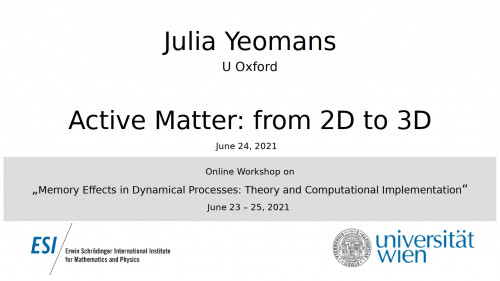Memory Effects in Dynamical Processes: Theory and Computational Implementation
In statistical physics, one frequently deals with processes that involve a very large number of degrees of freedom, implying significant computational cost if one needs to resolve all microscopic trajectories. However, there is a wide class of dynamical phenomena that can be described by the evolution of a reduced set of variables. The most direct way to get to a description of this kind is to apply coarse-graining procedures [1, 2]. Another way to simplify many-body problems is to go even beyond coarse-grained interactions and to study the dynamics of a restricted set of observables. One often refers to such variables as ‘reaction coordinates’, and one demands that their value at a certain time yields a good description of the global state of the system and captures its main features. But the link between the dynamics of a reaction coordinate and the (actual) microscopic dynamics is rarely trivial.
As a generalization of Langevin’s pioneering works, Robert Zwanzig has shown in the early 1960s that the equations governing the dynamics of coarse-grained variables and reaction coordinates must necessarily be non-local in time [3]. The consequence of which are so-called ‘non-Markovian’ or ‘memory’ effects: not only its current state but also the past history of the system impacts its subsequent evolution. Memory effects can appear in various forms and thus are treated numerically in different ways. The common feature of the underlying equations is the presence of so-called memory kernels, which are the functions that control the extent of the memory. In this workshop, we aim at gathering experts on memory effects from different sub-fields (hydrodynamics [4–6], biophysics [7, 8], materials science [9, 10], statistical physics [11–18], glasses [19]) in order to share experience and knowledge about these problems. The current challenges are multiple but we can summarize them as follows.
There is as of yet no deep understanding, general consensus and widely accepted methods on:
1. How to systematically derive equations of motion for reaction coordinates or coarse-grained degrees of freedom, and models for memory functions for systems that are out of thermal equilibrium.
There are currently multiple available methods to formalize memory effects, going from ad hoc formulations to formal projection operator derivations [20, 21]. As a result, the equations take very different shapes: first- or second-order integro-differential equations [22,23], memory kernels that can be space-dependent or even dependent on other variables [24], etc. We aim at discussing the various forms that non-Markovian effects can be written in and their potential strengths and weaknesses.
2. How to numerically deal with complex integro-differential equations of motion in an efficient way.
When the memory kernel has a long time extent, as for instance is frequently encountered in hydrodynamics [25, 26], the well-known numerical solvers quickly become obsolete. Fourier-Laplace analysis is often a useful tool to deconvolute the memory terms [27], but it is unfortunately not possible to apply such methods out of equilibrium. We plan to review the recent advancements on this issue.
3. How to consistently establish a link between a Langevin description, on the level of the single experiment, and a Fokker-Planck description for the probability density of the reaction coordinates.
In equilibrium and Markovian processes, the correspondence is well established, but it becomes less clear for more complex processes. One option to create a link to generalized Langevin equations is the use of fractional Fokker-Planck equations [28, 29], but there are also other possible ways [30, 31].
References
[1] M. G. Saunders, G. A. Voth (2013). Coarse-graining methods for computational biology. Annual Review of Biophysics 42, 73.
[2] H. I. Ingólfsson, C. A. Lopez, J. J. Uusitalo, D. H. de Jong, S. M. Gopal, X. Periole, S. J. Marrink (2014). The power of coarse-graining in biomolecular simulations. Wiley Interdisciplinary Reviews: Computational Molecular Science 4, 225.
[3] R. Zwanzig (1961). Memory effects in irreversible thermodynamics. Physical Review 124, 983.
[4] R. Matas-Navarro, R. Golestanian, T. B. Liverpool, S. M. Fielding (2014). Hydrodynamic suppression of phase separation in active suspensions. Physical Review E 90, 032304.
[5] D. Lesnicki, R. Vuilleumier, A. Carof, B. Rotenberg (2016). Molecular hydrodynamics from memory kernels. Physical Review Letters 116(14), 147804.
[6] J. Urzay, A. Doostmohammadi, J. Yeomans (2017). Multi-scale statistics of turbulence motorized by active matter. Journal of Fluid Mechanics 822, 762.
[7] F. Höfling, T. Franosch (2013). Anomalous transport in the crowded world of biological cells. Reports on Progress in Physics 76(4), 046602.
[8] A. E. Cardenas, R. Elber (2016). Markovian and non-Markovian modeling of membrane dynamics with milestoning. The Journal of Physical Chemistry B 120(33), 8208.
[9] E. Brini, E. A. Algaer, P. Ganguly, C. Li, F. Rodriguez-Ropero, N. F. van der Vegt (2013). Systematic coarse-graining methods for soft matter simulations – a review. Soft Matter 9(7), 2108.
[10] S. Jabbari-Farouji, J. Rottler, O. Lame, A. Makke, M. Perez, J.-L. Barrat (2015). Plastic deformation mechanisms of semicrystalline and amorphous polymers. ACS Macro Letters 4, 147.
[11] T. Franosch (2014). Long-time limit of correlation functions. Journal of Physics A: Mathematical and Theoretical 47(32), 325004.
[12] J. M. Brader, M. Schmidt (2014). Dynamic correlations in Brownian many-body systems. The Journal of Chemical Physics 140(3), 034104.
[13] G. Hummer, A. Szabo (2015). Optimal dimensionality reduction of multistate kinetic and Markov-state models. The Journal of Physical Chemistry B 119(29), 9029.
[14] X. Wu, B. R. Brooks, E. Vanden-Eijnden (2016). Self-guided Langevin dynamics via generalized Langevin equation. Journal of Computational Chemistry 37(6), 595.
[15] P. Español, P. B. Warren (2017). Perspective: Dissipative particle dynamics. The Journal of Chemical Physics 146(15), 150901.
[16] H. Meyer, T. Voigtmann, T. Schilling (2017). On the non-stationary Generalized Langevin Equation. The Journal of Chemical Physics 147, 214110.
[17] Y. Yoshimoto, Z. Li, I. Kinefuchi, G. E. Karniadakis (2017). Construction of non-Markovian coarse-grained models employing the Mori-Zwanzig formalism and iterative Boltzmann inversion. The Journal of Chemical Physics 147(24), 244110.
[18] M. Vrugt, R. Wittkowski (2019). Mori-Zwanzig projection operator formalism for systems with time-dependent Hamiltonians. Physical Review E 99, 062118.
[19] L. Klochko, J. Baschnagel, J. P. Wittmer, A. N. Semenov (2018). Long-range stress correlations in viscoelastic and glass-forming fluids. Soft Matter 14, 6835.
[20] C. Hijón, P. Español, E. Vanden-Eijnden, R. Delgado-Buscalioni (2010). Mori-Zwanzig formalism as a practical computational tool. Farady Discussions 144, 301.
[21] Z. Li, X. Bian, X. Li, G. E. Karniadakis (2015). Incorporation of memory effects in coarse-grained modeling via the Mori-Zwanzig formalism. The Journal of Chemical Physics 143, 243128.
[22] D. R. Reichman, P. Charbonneau (2005). Mode-coupling theory. Journal of Statistical Mechanics: Theory and Experiment 2005(05), P05013.
[23] J. H. Jeon, R. Metzler (2010). Fractional Brownian motion and motion governed by the fractional Langevin equation in confined geometries. Physical Review E 81(2), 021103.
[24] G. Jung, M. Hanke, F. Schmid (2018). Generalized Langevin dynamics: construction and numerical integration of non-Markovian particle-based models. Soft Matter 14(46), 9368.
[25] S. R. Williams, G. Bryant, I. K. Snook, W. van Megen (2006). Velocity autocorrelation functions of hard-sphere fluids: Long-time tails upon undercooling. Physical Review Letters 96(8), 087801.
[26] A. Fiege, R. Aspelmeier, A. Zippelius (2009). Long-time tails and cage effect in driven granular fluids. Physical Review Letters 102(9), 098001.
[27] A. V. Mokshin, R. M. Yulmetyev, P. Hänggi (2005). Simple measure of memory for dynamical processes described by a generalized Langevin equation. Physical Review Letters 95(20), 200601.
[28] M. Magdziarz, A. Weron, J. Klafter (2008). Equivalence of the fractional Fokker-Planck and subordinated Langevin equations: the case of a time-dependent force. Physical Review Letters, 101(21), 210601.
[29] B. I. Henry, T. A. M. Langlands, P. Straka (2010). Fractional Fokker-Planck equations for subdiffusion with space-and time-dependent forces. Physical Review Letters 105(17), 170602.
[30] L. Giuggioli, T. J. McKetterick, V. M. Kenkre, M. Chase (2016). Fokker–Planck description for a linear delayed Langevin equation with additive Gaussian noise. Journal of Physics A: Mathematical and Theoretical 49(38), 384002.
[31] T. Maltba, P. A. Gremaud, D. M. Tartakovsky (2018). Nonlocal PDF methods for Langevin equations with colored noise. Journal of Computational Physics 367, 87.
Understanding causation via correlations and linear response theory
Generalized Langevin Equations in time-dependent contexts
Jerky active matter model: particle dynamics with translational and orientational memory
Data-driven Langevin equations from transition path sampling trajectories
Cross-correlation corrected friction in (generalized) Langevin models
Computing memory kernels from noise reconstruction by a deterministic approach
Computing memory kernels from noise reconstruction by a stochastic approach
Active Matter: from 2D to 3D
Persistent correlations in colloidal suspensions -- noise cancellation algorithm
Aging in glasses: generalized Langevin equations and scaling laws
Memory Kernels and Fluctuation-Dissipation Relations far from Equilibrium
Spectral approaches to memory: friction in liquids and a generalised master equation
Power functional perspective on memory in liquids
- Jeanine Shea (U. Mainz) : Memory effects and stochastic forces on a passive particle in an active bath
- Branislav Nikolic (U. Delaware) : Non-Markovian damping, magnetic inertia and geometric torque in the Landau-Lifshitz-Gilbert equation self-consistently coupled to electronic time-dependent nonequilibrium Green functions
- Péter Király (U. Loránd Eötvös) : Replacement of the solvent component by random forces of all-atom simulation statistical distributions
- Jaehyeok Jin (U. Chicago): Bottom-up Coarse-Graining of Many-body Mesoscopic Models of Fluids
Memory in subnetwork dynamics
Kinetics of structure formation in multicomponent polymer systems
Mechanical memory effects in solid-like polymers
Ductile and brittle yielding in amorphous materials
Machine-Learning Many-Body Potentials for Colloidal Systems
Generalized Langevin equations for simulating nuclear quantum effects
Organizers
| Name | Affiliation |
|---|---|
| Christoph Dellago | University of Vienna |
| Anja Kuhnhold | University of Freiburg |
| Hugues Meyer | University of Saarland |
| Tanja Schilling | University of Freiburg |
Attendees
| Name | Affiliation |
|---|---|
| Sara Bonella | EPFL, Lausanne |
| Moritz Bültmann | University of Freiburg |
| Daniel de las Heras | University of Bayreuth |
| Marjolein Dijkstra | Utrecht University |
| Suzanne Fielding | Durham University |
| Thomas Franosch | University of Innsbruck |
| Fabian Glatzel | University of Freiburg |
| Martin Hanke | Johannes-Gutenberg Universität Mainz |
| Felix Höfling | Freie Universität Berlin |
| Sara Jabbari-Farouji | University of Amsterdam |
| Jaehyeok Jin | University of Chicago |
| Gerhard Jung | University of Innsbruck |
| Péter Király | Eötvös Loránd University Budapest |
| Viktor Klippenstein | Technical University Darmstadt |
| Rituparno Mandal | Georg-August-Universität |
| Marcus Müller | University of Göttingen |
| Martin Oettel | University of Tübingen |
| Karen Palacio-Rodríguez | Sorbonne University |
| Harald Posch | University of Vienna |
| Benjamin Rotenberg | CNRS Paris |
| Friederike Schmid | Johannes-Gutenberg Universität Mainz |
| Matthias Schmidt | University of Bayreuth |
| Jeanine Shea | Johannes-Gutenberg Universität Mainz |
| Peter Sollich | Georg-August-Universität |
| Marco Spinaci | Ca’ Foscari University of Venice |
| Diego Tapias | Georg-August-Universität |
| Gergely Tóth | Eötvös Loránd University Budapest |
| Madhusmita Tripathy | Technical University Darmstadt |
| Thomas Voigtmann | Deutsches Zentrum für Luft- und Raumfahrt |
| Hadrien Vroylandt | Sorbonne University |
| Rodolphe Vuilleumier | Ecole Normale Superieure |
| Angelo Vulpiani | La Sapienza University of Rome |
| Raphael Wittkowski | University of Münster |
| Julia Yeomans | University of Oxford |
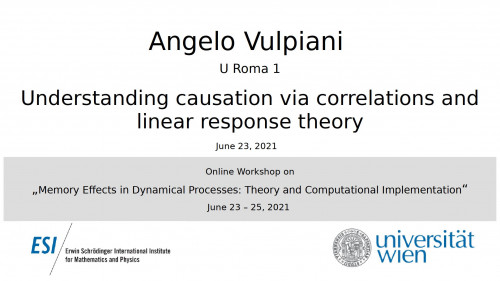
June 23, 2021 14:15 — 14:45
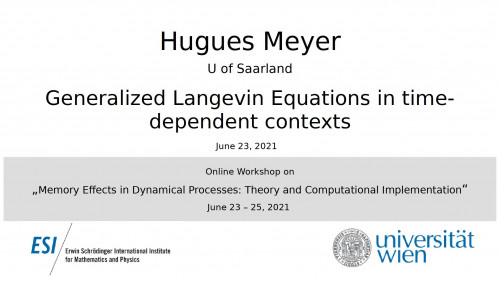
June 23, 2021 14:45 — 15:15
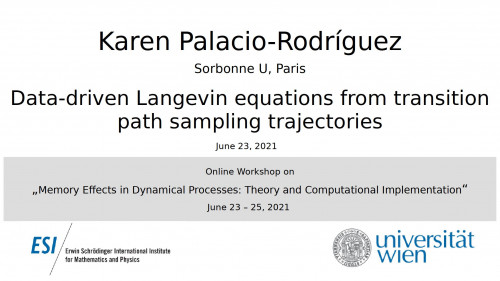
June 23, 2021 16:15 — 16:45
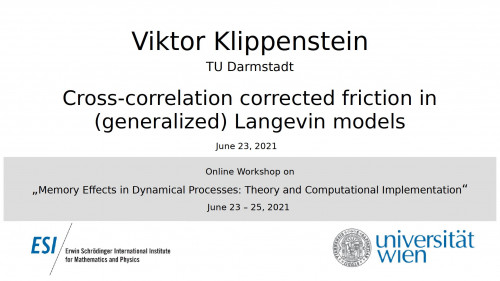
June 23, 2021 16:45 — 17:15
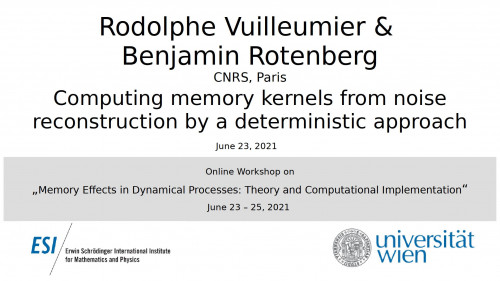
June 23, 2021 17:15 — 17:45
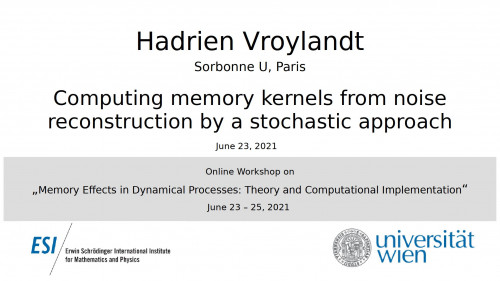
June 23, 2021 17:45 — 18:15
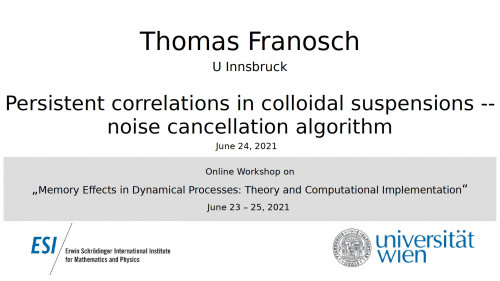
June 24, 2021 15:00 — 15:30
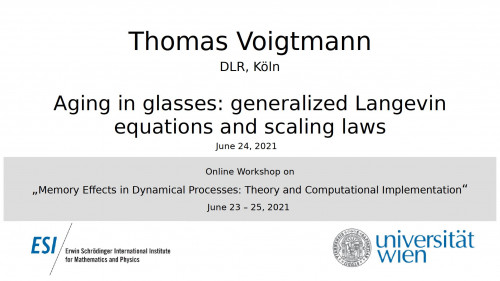
June 24, 2021 15:30 — 16:00
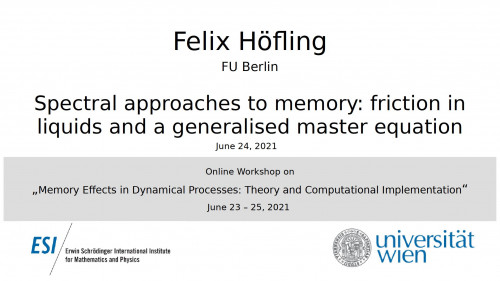
June 24, 2021 17:00 — 17:30
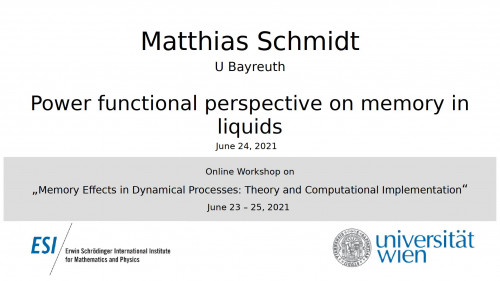
June 24, 2021 17:30 — 18:00
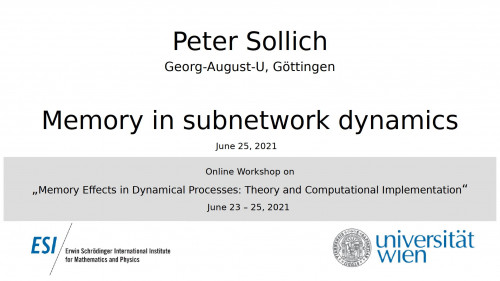
June 25, 2021 14:00 — 14:30
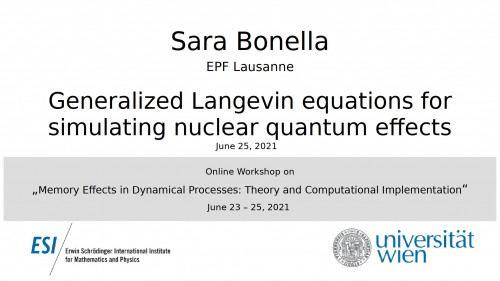
June 25, 2021 17:00 — 17:30
- Type:
- Online Workshop
- When:
- June 23, 2021 — June 25, 2021
- Where:
- ESI Boltzmann Lecture Hall
- Organizer(s):
-
Christoph Dellago (U of Vienna)
Anja Kuhnhold (U of Freiburg)
Hugues Meyer (U of Saarland)
Tanja Schilling (U of Freiburg)
